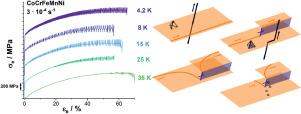当前位置:
X-MOL 学术
›
Acta Mater.
›
论文详情
Our official English website, www.x-mol.net, welcomes your feedback! (Note: you will need to create a separate account there.)
Dislocation-based Serrated Plastic Flow of High Entropy Alloys at Cryogenic Temperatures
Acta Materialia ( IF 9.4 ) Pub Date : 2020-11-01 , DOI: 10.1016/j.actamat.2020.09.052 A.S. Tirunilai , T. Hanemann , K.-P. Weiss , J. Freudenberger , M. Heilmaier , A. Kauffmann
Acta Materialia ( IF 9.4 ) Pub Date : 2020-11-01 , DOI: 10.1016/j.actamat.2020.09.052 A.S. Tirunilai , T. Hanemann , K.-P. Weiss , J. Freudenberger , M. Heilmaier , A. Kauffmann

|
Abstract Serrated plastic deformation at temperatures close to 0 K has been previously reported in some metals and alloys, and is associated with two possible origins: (i) thermomechanical instability or (ii) mechanical instability. While some recent results indicate that serrations are a mechanical dislocation-based phenomenon, a comprehensive model does not exist. CoCrFeMnNi, an expectedly ideal candidate, exhibits severe serrated plastic deformation with large stress drops in excess of 100 MPa. Furthermore, it also shows cryogenic serrated plastic deformation at a higher temperature (35 K) than previously reported for any other alloy. The exacerbated nature of serrated plastic deformation in CoCrFeMnNi led to the following inferences: (i) temperature and dislocation density are indisputable controlling parameters for cryogenic serrated plastic deformation and they cannot supersede each another; (ii) a phenomenological model is elucidated based on the increasing difficulty for cross-slip with decreasing temperature, leading to sudden massive dislocation proliferation event; (iii) the model establishes a gradual transition from completely non-serrated to completely serrated deformation, mediated by cross-slip, as opposed to the conventional model which proposed a discrete transition; (iv) solute dislocation interaction and associated Stacking Fault Energy (SFE) during deformation plays a key role in controlling dislocation constriction and cross-slip and correspondingly serrated plastic deformation; (v) the need/direct influence of deformation twinning, transformation induced plasticity and especially thermomechanical factors on serrated plastic deformation is invalidated. Some of these points were further clarified through comparisons with CoCrNi and CoNi, also presented in the present article.
中文翻译:

低温下高熵合金的基于位错的锯齿状塑性流动
摘要 在接近 0 K 的温度下,锯齿状塑性变形在某些金属和合金中已有报道,并且与两种可能的起源有关:(i) 热机械不稳定性或 (ii) 机械不稳定性。虽然最近的一些结果表明锯齿是一种基于机械位错的现象,但不存在综合模型。CoCrFeMnNi 是一种理想的候选材料,表现出严重的锯齿状塑性变形,应力降超过 100 MPa。此外,它还显示出在比之前报道的任何其他合金更高的温度 (35 K) 下的低温锯齿状塑性变形。CoCrFeMnNi 中锯齿状塑性变形的加剧性质导致以下推论:(i) 温度和位错密度是低温锯齿状塑性变形无可争议的控制参数,它们不能相互替代;(ii) 基于温度降低交叉滑移难度增加,导致突然的大规模位错扩散事件,阐明了现象学模型;(iii) 该模型建立了从完全非锯齿状变形到完全锯齿状变形的逐渐过渡,由交叉滑移介导,与提出离散过渡的传统模型相反;(iv) 变形过程中的溶质位错相互作用和相关的层错能 (SFE) 在控制位错收缩和交叉滑移以及相应的锯齿状塑性变形方面起着关键作用;(v) 变形孪生的需要/直接影响,相变诱导塑性,尤其是热机械因素对锯齿状塑性变形的影响无效。通过与 CoCrNi 和 CoNi 的比较,进一步阐明了其中一些要点,也在本文中进行了介绍。
更新日期:2020-11-01
中文翻译:

低温下高熵合金的基于位错的锯齿状塑性流动
摘要 在接近 0 K 的温度下,锯齿状塑性变形在某些金属和合金中已有报道,并且与两种可能的起源有关:(i) 热机械不稳定性或 (ii) 机械不稳定性。虽然最近的一些结果表明锯齿是一种基于机械位错的现象,但不存在综合模型。CoCrFeMnNi 是一种理想的候选材料,表现出严重的锯齿状塑性变形,应力降超过 100 MPa。此外,它还显示出在比之前报道的任何其他合金更高的温度 (35 K) 下的低温锯齿状塑性变形。CoCrFeMnNi 中锯齿状塑性变形的加剧性质导致以下推论:(i) 温度和位错密度是低温锯齿状塑性变形无可争议的控制参数,它们不能相互替代;(ii) 基于温度降低交叉滑移难度增加,导致突然的大规模位错扩散事件,阐明了现象学模型;(iii) 该模型建立了从完全非锯齿状变形到完全锯齿状变形的逐渐过渡,由交叉滑移介导,与提出离散过渡的传统模型相反;(iv) 变形过程中的溶质位错相互作用和相关的层错能 (SFE) 在控制位错收缩和交叉滑移以及相应的锯齿状塑性变形方面起着关键作用;(v) 变形孪生的需要/直接影响,相变诱导塑性,尤其是热机械因素对锯齿状塑性变形的影响无效。通过与 CoCrNi 和 CoNi 的比较,进一步阐明了其中一些要点,也在本文中进行了介绍。



























 京公网安备 11010802027423号
京公网安备 11010802027423号